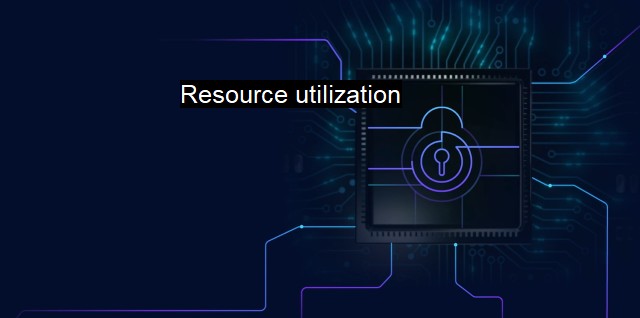What is Resource utilization?
Optimizing Resource Utilization for Effective Cybersecurity and Antivirus Protection
"Resource utilization" refers to the effective and efficient usage of available resources – inclusive of human, technologic, or otherwise – typically with the overarching goal to optimally achieve a predefined objective. In the spectrum of cyber security and antivirus, this phrase acquires a unique sense. It indicates how these cybersecurity tools and practices consume the resources of a computer system while ensuring complete protection against potential cyber threats.Cybersecurity tools like antiviruses are elaborate software created to prevent, detect, and contend with malicious software or unauthorized intrusion. Some resources of a computer system, such as RAM (Random Access Memory), CPU (Central Processing Unit), disk space, battery life, and network space, provide an isolated but synchronized workspace for all installed programs, including security tools.
The effective functioning of these tools depends considerably on resource utilization. The house of cybersecurity, as it seems, cannot stand on feeble stilts. Thus, it is essential to efficiently manage the computing power allocated to cyber security tools as this can directly affect overall performance.
The aspects of resource utilization can be delved into further by conceptualizing it into different sections, governed by the resources' usage area. Prime ones include processing power and memory.
The utilization of processing power by a cybersecurity measures module, particularly antivirus, is crucial. If excessive, it may cause the system to lag, hence impeding productivity. The optimization of CPU usage is an integral part of resource utilization. Developers today use strategies such as swapping, multi-tasking, load balancing, among many others, to optimize CPU use by their software.
Memory control is another indispensable element. Reasonable proportioning among active processes, optimum data transferring, scheduled data fetching are some methods for effective resource utilization in this manner. Efficient memory management sequences allow the cybersecurity tools to provide full-time monitoring service without interfering with the seamless performance of other system operations.
Disk I/O management is the management of input and output operations on the physical storage disk. Cybersecurity tools require disk space for functionality providers such as logs, data backup, backup recovery, and quarantine actions. If left unoptimized, these tasks can crowd the storage space, reducing efficiency and speed. Required optimization can take the form of temporal management directives defining what, when, and how access to the disk occurs.
Networking is another area for optimal resource utilization. Cybersecurity tools frequently require updates; therefore, they need to connect to the server via the internet constantly. As the rate of connectively grows, more bandwidth is consumed. Efficient management of network resources becomes primordial as it has a directly proportional relation to the user’s experience.
One mitigation strategy includes the introduction of SIEM (security information and event management) systems, which can analyze and interpret the many data from networked devices, delineating irregular patterns, never failing to dispatch warnings whenever aberrant conduct is detected. Another precedence includes the implementation of Intercept X AI technology by Sophos, an antivirus giant best known for its fortifying updates that enable little to no consumption of further network resources once they have been thoroughly used for data learning.
Managing resource utilization is a balance. Developers and cybersecurity officers must always strive to achieve maximal resource utilization without adversely impacting the system's performance. This balanced approach allows the cybersecurity infrastructure to weave safety layers around the digital world while preserving the seamless functionalities of the beast that is modern-day technology.

Resource utilization FAQs
What is resource utilization?
Resource utilization refers to the amount of computer resources such as CPU, memory, and storage that are being consumed by a program or process at a given time. In the context of cybersecurity and antivirus, it can refer to the amount of resources being used by the antivirus software to scan for and detect threats on a system.Why is resource utilization important in cybersecurity and antivirus?
Resource utilization is important in cybersecurity and antivirus because antivirus software that utilizes too much system resources can cause a system to slow down, negatively impacting its performance. Additionally, if an antivirus program is taking up too many resources, it may not be able to effectively detect and remove threats from a system.What factors can affect resource utilization in antivirus software?
Several factors can affect resource utilization in antivirus software, including the size and complexity of the files being scanned, the number of files being scanned simultaneously, the frequency of scans, and the specific settings or options enabled within the antivirus software.Can resource utilization be controlled in antivirus software?
Yes, resource utilization can often be controlled in antivirus software by adjusting the settings or options within the program. For example, users may be able to adjust the frequency of scans, limit the number of files being scanned simultaneously, or adjust the intensity of the scan. Antivirus programs may also feature different scan modes, such as quick scans or full system scans, that can affect resource utilization.| | A | | | B | | | C | | | D | | | E | | | F | | | G | | | H | | | I | | | J | | | K | | | L | | | M | |
| | N | | | O | | | P | | | Q | | | R | | | S | | | T | | | U | | | V | | | W | | | X | | | Y | | | Z | |
| | 1 | | | 2 | | | 3 | | | 4 | | | 7 | | | 8 | | |||||||